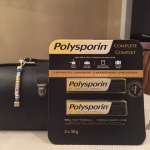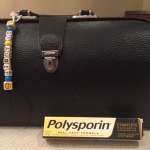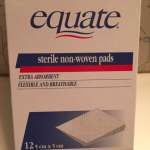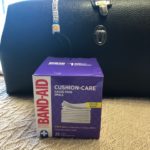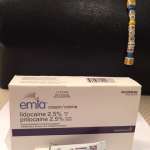Infant Circumcision
The ideal age is between 5-10 days. If the baby is unwell, this will necessitate some minor delay until he has recovered. Circumcision can be easily performed up to 1 month of age and I will not perform a circumcision on a baby older than 1 month of age. The younger the baby is, the easier it is on him, and the adage “the sooner, the better” certainly applies.
- This contains a topical anesthetic and is the BEST! A 2-pack of Polysporin Complete is available at Costco.
- The Green or Burgundy tubes of Polysporin are also OK.
- DO NOT BUY Polysporin CREAM.
2. Two boxes of Johnson & Johnson 2 x 2 inch (5 x 5 cm.)
First Aid Gauze Pads (one large box of 25 will do).
- Generic brands are just as good or better including Equate, Exact, Life Brand, Rexall.
- DO NOT BUY Quick Stop, Easy Release or Non-Stick gauze or a roll of gauze.
3. Small 5g tube of EMLA cream.
- This recommended anesthetic cream is available over the counter.
- Apply a liberal amount of EMLA to the baby’s penis one hour before the Circumcision and place a piece of saran wrap over the penis to prevent the EMLA from rubbing off on his diaper.
Click here to watch my “Demonstration of EMLA Application” video.
4. Infant Tylenol or Tempra drops (80mg/ml).
5. Sturdy Table – One end of the dining room or kitchen table is best. A card table or other type of folding table (at least 36 inches wide) is absolutely perfect.
6. Large (adult size) bath towel.
7. Two disposable diapers and baby wipes.
8. Make sure there is adequate lighting for the Circumcision.
I do not routinely see the baby before the day of the circumcision as I rely on the pediatrician to inform you of any health concerns. Please inform me if there is a Family History of Bleeding Disorders or any other health concerns.
Note: The baby must have his Vitamin K shot prior to circumcision
Tempra or Tylenol need not be given before the circumcision. It may be given after the circumcision if needed. (See Aftercare 3. Temperament- below)
Feeding the baby before the circumcision is fine but try to hold off for 1½-2 hours so that he will find it soothing right afterwards.
An easy access outfit is best such as a nighty or gown with an open or drawstring bottom. Sleepers are fine. Snaps and zippers are fine but avoid buttons. An undershirt is not necessary.
I prefer to have a parent holding the baby gently while I perform the circumcision.
This is easy to do by placing the baby on a sturdy table with a clean folded towel underneath him for padding.
With either parent sitting opposite the table from me, you will be able to reach forward to gently hold the baby’s legs during the circumcision.
Total holding time is 2 minutes with the actual circumcision taking 30 seconds.
I find this gentle human touch very comforting to the baby compared to a board with Velcro straps.
The Circumcision is accomplished in 3 simple steps:
- The foreskin is gently separated from the head of the penis using a small smooth blunt probe.
- The foreskin to be removed is drawn above the head of the penis and the Mogen Clamp is placed. This protects the head of the penis below the clamp while the 1 second cut is made.
- The Mogen Clamp is removed and the skin is pushed back to reveal the head of the now circumcised penis.
Following the circumcision, I will clean up for five minutes and then together with both parents complete the first diaper change. I will thoroughly explain the aftercare and point out a few things regarding the baby‘s penis. In general, the appearance remains the same for approximately three days. I will phone you the next day to check on the baby’s progress and to answer any questions you may have.
The first diaper should be changed within 2 hours after the circumcision. Subsequent diapers can remain on for the usual 3-4 hours.
1. Spotting – is normal for the first 24 hours and is no reason for concern. If active bleeding (blood flowing) is noted, firm pressure should be applied to the penis with a piece of gauze for 3-4 minutes and if the bleeding continues, your physician or I should be contacted immediately.
2. Bandage – Gauze and polysporin dressings should be used with each diaper change for three days after the circumcision. Open a 2 x 2 inch gauze pad once, so that it becomes 4 x 2 inches. Apply a liberal amount of polysporin to one side and spread it around. Place the gauze, polysporin side down to form a “tent or cap” over the penis and close the diaper.
3. Temperament – Your baby may be slightly fussier than normal for the first 24 hours. He should be held, cuddled and fed and can be given 40 mg (½ ml = 0.5 ml) of acetaminophen liquid (Tempra, Tylenol) every 4-6 hours if necessary. Most babies behave no differently after the circumcision than before.
4. Bathing – Sponge baths are suggested for the first three days after the circumcision. During this time, the penis can be cleaned if necessary by squeezing warm water over it from a wash cloth. Immersion may take place beginning the fourth day. Drying should be accomplished by gentle patting. Soaps are permitted but should not be applied to the penis itself.
5. Urination – Urine is normally sterile and will not cause any stinging or irritation.
6. Stooling – The scrotum tends to prevent stool from contacting the penis, however, this may occur. If so, squeeze water over the penis from a warm washcloth and then wipe or dab the penis gently with the washcloth until clean. In general, immediate diaper changing is recommended after each stool.
7. Baby Wipes and Barrier Creams (Sudocrem, Zincofax, Vaseline, Penaten) – These are permitted on the buttocks and groins but should not be applied directly to the penis.
8. Sleeping – Baby’s sleeping position is unimportant and placing him on his stomach is permitted after the umbilical cord has fallen off.
9. Healing – Complete healing will take from 10 – 14 days. The wound site at this point is a mucosal surface just like your lips and the inside of your mouth. Therefore, the changes that occur will be present immediately following the circumcision and the following will be noted:
- Redness – this is normal and may take two weeks to disappear.
- Swelling – primarily on the underside. This will appear as a shiny pink roll (or lip) of tissue between the head and shaft of the penis and might not always be symmetrical. The swelling may not start to diminish for three or four days.
- Scabbing – due to the mucosal nature of this skin, if present at all, the scab will be a whitish or light yellowish crust or film. It will be noticeable mostly on the underside but may be on top or even on the head of the penis as well. This crust will be adherent to the penis and will disappear on its own. It should not be removed.
- Infection – this is rare and occurs in less than 1% of cases. If the swelling is thought to be increasing after the first 36 hours, or if there is increasing redness or a creamy discharge from the wound, infection should be considered and you should contact your physician or me immediately.
As a matter of routine, I will phone you the next day to check on the baby‘s progress and to answer any questions you may have.
The range of cost is $550.00-$700.00** for medical/non-ritual circumcision.
(**Depends on location. Surcharges apply for travel and for infants older than 3 weeks of
age)
Methods of Payment: Cash, Check or Interac Transfer
Every baby has unique anatomy. I use my expertise to examine the baby’s anatomy to achieve the best possible aesthetic result.
Concealed Penis – If the baby has a lot of pubic fat, the head of the penis may slip inside like the head of a turtle. I will show you how to deal with this easily, to prevent problems in the future such as adhesions (see below). This is most prone to occur at 3-6 months of age as the baby accumulates more pubic fat and before his penis has a chance to grow. If at any time when changing the baby you are unable to see the entire head of the penis, press down firmly with two fingers at the base of the penis so that it “pops out”. Continue to do this with every diaper change – you will not hurt him. For more information on this topic, please click here.
Rotated Penis – This occurs in approximately 15% of babies, usually counter clockwise. This is a normal variant which I will point out to you if present.
Late Bleeding – Occasionally there is slight fresh bleeding on day 5-7 post-op. This occurs if the scab shrinks or separates from the skin edge or from the head of the penis and it is similar to the bleeding one might see when the umbilical stump is separating. It is of no major concern but gauze and polysporin should be reapplied for a further 12-24 hours to prevent sticking.
Gauze is stuck! – This can happen if the original gauze stays on for too long, especially the 1st or 2nd post-op diaper. Soak the gauze with warm water for a few minutes and it should peel off easily. Make sure to use extra polysporin on the next diaper.
Colour – The head of the penis (glans) is a very vascular organ. This means there are a lot of small blood vessels under the surface. Depending on ambient temperature and state of arousal, the color may appear pink, red or bluish. This is of no concern.
Adhesions – Occasionally, the skin on the shaft of the penis will seem to creep forward and stick to the corona (base of the glans). If this happens, I can show you how to gently push the skin back to prevent permanent adhesions.


